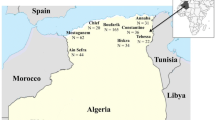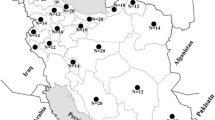Abstract
Polyandry is a specific phenomenon increasing genetic diversity. To analyze the level of polyandry and to assess the contribution of drones to the genetic diversity of honey bee colonies, three microsatellite loci (A008, Ap049, and AC117) were studied in honey bees from colonies of different origin (Middle Russian race, Carpathian race, and hybrids) in Tomsk Province. The share of the introduced paternal alleles varied between colonies from 6.67 to 28.00%. The highest genetic diversity was observed in hybrid colonies (25–28% of introduced paternal alleles).
Similar content being viewed by others
References
Brodschneider, R., Arnold, G., Hrassnigg, N., and Crailsheim, K., “Does Patriline Composition Change over a Honey Bee Queen’s Lifetime?” Insects 3, 857–869 (2012).
Brovarsky, V.D., “Migration of Sperm in the Bee Queen’s Reproductive System,” Pchelovodstvo, No. 4, 20–22 (2014).
Cauia, E., Usurelu, D., Magdalena, L.M., Cimponeriu, D., Apostol, P., et al., “Preliminary Researches Regarding the Genetic and Morphometric Characterization of Honeybee (A. mellifera L.) from Romania,” Zootehnie si Biotehnologii 41 2, 278–286 (2008).
Couvillon, M.J., Hughes, W.O.H., Perez-Sato, J.A., Martin, S.J., Roy, G.G.F., and Ratnieksa, F.L.W., “Sexual Selection in Honey Bees: Colony Variation and the Importance of Size in Male Mating Success,” Behavioral Ecology 21 1, 520–525 (2010).
DeFelice, D.S., Ross, C., Simone-Finstrom, M., Warrit, N., Smith, D.R., et al., “Geographic Variation in Polyandry of the Eastern Honey Bee, Apis cerana, in Thailand,” Insectes Sociaux 62 1, 37–42 (2015).
Evison, S.E.F., Fazio, G., Chappell, P., Foley, K., Jensen, A.B., and Hughes, W.O.H., “Host–Parasite Genotypic Interactions in the Honey Bee: the Dynamics of Diversity,” Ecology and Evolution 3, 2214–2222 (2013).
Fushs, S. and Moritz, R.F.A., “Evolution of Extreme Polyandry in the Honeybee Apis mellifera L.,” Behavioral Ecology and Sociobiology 9, 269–275 (1998).
Haberl, M. and Tautz, D., “Sperm Usage in Honey Bee,” Behavioral Ecology and Sociobiology 42, 247–255 (1998).
Kraus, F.B., Neumann, P., Van Praagh, J., and Moritz, R.F.A., “Sperm Limitation and the Evolution of Extreme Polyandry in Honeybees (Apis mellifera L.),” Behavioral Ecology and Sociobiology 55, 494–501 (2004).
Laidlaw, H.H. and Page, R.E., “Polyandry in Honey Bees (Apis mellifera L.): Sperm Utilization and Intracolony Genetic Relationships,” Genetics 108, 985–997 (1984).
Mattila, H.R. and Seeley, T.D., “Genetic Diversity in Honey Bee Colonies Enhances Productivity and Fitness,” Science 317, 362–364 (2007).
Mattila, H.R. and Seeley, T.D., “Extreme Polyandry Improves a Honey Bee Colony’s Ability to Track Dynamic Foraging Opportunities via Greater Activity of Inspecting Bees,” Apidologie 45, 347–363 (2014).
Mattila, H.R., Burke, K.M., and Seeley, T.D., “Genetic Diversity within Honeybee Colonies Increases Signal Production by Waggle-Dancing Foragers,” Proceedings of the Royal Society B 275, 809–816 (2008).
Ostroverkhova, N.V., Konusova, O.L., Kucher, A.N., Kireeva, T.N., Vorotov, A.A., and Belykh, E.A., “Genetic Diversity of the Locus COI-COII of Mitochondrial DNA in Honeybee Populations (Apis mellifera L.) from the Tomsk Region,” Genetika 51 1, 89–100 (2015) [Russian Journal of Genetics 51 1, 80–90 (2015)].
Page, R.E., “The Evolution of Multiple Mating Behavior by Honey Bee Queens Apis mellifera L.,” Genetics 96, 263–273 (1980).
Palmer, K.A. and Oldroyd, B.P., “Evidence for Intra- Colonial Genetic Variance in Resistance to American Foulbrood of Honey Bees (Apis mellifera): Further Support for the Parasite/Pathogen Hypothesis for the Evolution of Polyandry,” Naturwissenschaften 90, 265–268 (2003).
Parpinelli, R.S., Ruvolo-Takasusuki, M.C.C., and Toledo, V.A.A., “MRJP Microsatellite Markers in Africanized Apis mellifera Colonies Selected on the Basis of Royal Jelly Production,” Genetics and Molecular Research 13 3, 6724–6733 (2014).
Ryazanova, G.I., “Reproductive Behavior of the Webbing Clothes Moth (Tineola bisselliella): Polyandry and Multiple Mating with the Same Male,” Zoologicheskii Zhurnal 90 10, 1188–1192 (2011) [Entomological Review 91 8, 949–953 (2011)].
Ryazanova, G.I., “Reproduction of the Indian Meal Moth (Plodia interpunctella, Lepidoptera, Pyralidae): Mating Success, Polygyny, Polyandry,” Zoologicheskii Zhurnal 92 8, 291–296 (2013) [Entomological Review 94 1, 29–34 (2014)].
Seeley, T.D. and Tarpy, D.R., “Queen Promiscuity Lowers Disease within Honeybee Colonies,” Proceedings of the Royal Society B 274, 67–72 (2007).
Solignac, M., Vautrin, D., Loiseau, A., Mougel, F., Baudry, E., et al., “Five Hundred and Fifty Microsatellite Markers for the Study of the Honey Bee (Apis mellifera L.) Genome,” Molecular Ecology Notes 3, 307–311 (2003).
Tarpy, D.R. and Page, R.E., “Sex Determination and the Evolution of Polyandry in Honey Bees (Apis mellifera),” Behavioral Ecology and Sociobiology 52, 143–150 (2002).
Tarpy, D.R., Caren, J.R., Delaney, D.A., Sammataro, D., Finley, J., et al., “Mating Frequencies of Africanized Honey Bees in the South-Western USA,” Journal of Apicultural Research and Bee World 49 4, 302–310 (2010).
Tarpy, D.R., van Engelsdorp, D., and Pettis, J.S., “Genetic Diversity Affects Colony Survivorship in Commercial Honey Bee Colonies,” Naturwissenschaften 100 8, 723–728 (2013).
Tarpy, D.R., Delaney, D.A., and Seeley, T.D., “Mating Frequencies of Honey Bee Queens (Apis mellifera L.) in a Population of Feral Colonies in the Northeastern United States,” PLoS One 10 (3) e0118734 (2015).
Author information
Authors and Affiliations
Corresponding author
Additional information
Original Russian Text © N.V. Ostroverkhova, O.L. Konusova, A.N. Kucher, T.N. Kireeva, 2016, published in Zoologicheskii Zhurnal, 2016, Vol. 95, No. 3, pp. 307–313.
Rights and permissions
About this article
Cite this article
Ostroverkhova, N.V., Konusova, O.L., Kucher, A.N. et al. Investigation of polyandry in honey bees (Apis mellifera) using microsatellites. Entmol. Rev. 96, 389–394 (2016). https://doi.org/10.1134/S0013873816040011
Received:
Published:
Issue Date:
DOI: https://doi.org/10.1134/S0013873816040011




